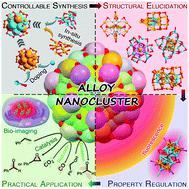当前位置:
X-MOL 学术
›
Chem. Soc. Rev.
›
论文详情
Our official English website, www.x-mol.net, welcomes your feedback! (Note: you will need to create a separate account there.)
Atomically precise alloy nanoclusters: syntheses, structures, and properties.
Chemical Society Reviews ( IF 46.2 ) Pub Date : 2020-08-06 , DOI: 10.1039/c9cs00633h Xi Kang 1 , Yingwei Li , Manzhou Zhu , Rongchao Jin
Chemical Society Reviews ( IF 46.2 ) Pub Date : 2020-08-06 , DOI: 10.1039/c9cs00633h Xi Kang 1 , Yingwei Li , Manzhou Zhu , Rongchao Jin
Affiliation

|
Metal nanoclusters fill the gap between discrete atoms and plasmonic nanoparticles, providing unique opportunities for investigating the quantum effects and precise structure–property correlations at the atomic level. As a versatile strategy, alloying can largely improve the physicochemical performances compared to the corresponding homo-metal nanoclusters, and thus benefit the applications of such nanomaterials. In this review, we highlight the achievements of atomically precise alloy nanoclusters, and summarize the alloying principles and fundamentals, including the synthetic methods, site-preferences for different heteroatoms in the templates, and alloying-induced structure and property changes. First, based on various Au or Ag nanocluster templates, heteroatom doping modes are presented. The templates with electronic shell-closing configurations tend to maintain their structures during doping, while the others may undergo transformation and give rise to alloy nanoclusters with new structures. Second, alloy nanoclusters of specific magic sizes are reviewed. The arrangement of different atoms is related to the symmetry of the structures; that is, different atoms are symmetrically located in the nanoclusters of smaller sizes, and evolve into shell-by-shell structures at larger sizes. Then, we elaborate on the alloying effects in terms of optical, electrochemical, electroluminescent, magnetic and chiral properties, as well as the stability and reactivity via comparisons between the doped nanoclusters and their homo-metal counterparts. For example, central heteroatom-induced photoluminescence enhancement is emphasized. The applications of alloy nanoclusters in catalysis, chemical sensing, bio-labeling, and other fields are further discussed. Finally, we provide perspectives on existing issues and future efforts. Overall, this review provides a comprehensive synthetic toolbox and controllable doping modes so as to achieve more alloy nanoclusters with customized compositions, structures, and properties for applications. This review is based on publications available up to February 2020.
中文翻译:

原子精确的合金纳米簇:合成,结构和性质。
金属纳米团簇填补了离散原子和等离激元纳米粒子之间的空白,为研究原子级的量子效应和精确的结构-性质相关性提供了独特的机会。作为一种通用策略,与相应的均金属纳米团簇相比,合金化可以大大改善其理化性能,从而有利于此类纳米材料的应用。在这篇综述中,我们重点介绍了原子精确的合金纳米簇的成就,并总结了合金化的原理和基本原理,包括合成方法,模板中不同杂原子的位置偏好以及合金化引起的结构和性能变化。首先,基于各种金或银纳米簇模板,提出了杂原子掺杂模式。具有电子壳闭合构造的模板在掺杂过程中倾向于保持其结构,而其他模板可能会发生转变并产生具有新结构的合金纳米团簇。其次,回顾了特定魔术尺寸的合金纳米团簇。不同原子的排列与结构的对称性有关。也就是说,不同的原子对称地位于较小尺寸的纳米簇中,并以较大尺寸演变为逐壳结构。然后,我们从光学,电化学,电致发光,磁性和手性性质以及稳定性和反应性方面阐述了合金化作用 审查了特定魔术尺寸的合金纳米团簇。不同原子的排列与结构的对称性有关。也就是说,不同的原子对称地位于较小尺寸的纳米簇中,并以较大尺寸演变为逐壳结构。然后,我们从光学,电化学,电致发光,磁性和手性性质以及稳定性和反应性方面阐述了合金化作用 审查了特定魔术尺寸的合金纳米团簇。不同原子的排列与结构的对称性有关。也就是说,不同的原子对称地位于较小尺寸的纳米簇中,并以较大尺寸演变为逐壳结构。然后,我们从光学,电化学,电致发光,磁性和手性性质以及稳定性和反应性方面阐述了合金化作用通过比较掺杂的纳米团簇和它们的同金属对应物。例如,强调了中心杂原子诱导的光致发光增强。进一步讨论了合金纳米簇在催化,化学传感,生物标记等领域的应用。最后,我们提供有关现有问题和未来工作的观点。总的来说,这篇综述提供了一个全面的合成工具箱和可控的掺杂模式,以便获得更多具有定制成分,结构和性能的合金纳米簇。这篇评论是根据截至2020年2月的出版物进行的。
更新日期:2020-09-01
中文翻译:

原子精确的合金纳米簇:合成,结构和性质。
金属纳米团簇填补了离散原子和等离激元纳米粒子之间的空白,为研究原子级的量子效应和精确的结构-性质相关性提供了独特的机会。作为一种通用策略,与相应的均金属纳米团簇相比,合金化可以大大改善其理化性能,从而有利于此类纳米材料的应用。在这篇综述中,我们重点介绍了原子精确的合金纳米簇的成就,并总结了合金化的原理和基本原理,包括合成方法,模板中不同杂原子的位置偏好以及合金化引起的结构和性能变化。首先,基于各种金或银纳米簇模板,提出了杂原子掺杂模式。具有电子壳闭合构造的模板在掺杂过程中倾向于保持其结构,而其他模板可能会发生转变并产生具有新结构的合金纳米团簇。其次,回顾了特定魔术尺寸的合金纳米团簇。不同原子的排列与结构的对称性有关。也就是说,不同的原子对称地位于较小尺寸的纳米簇中,并以较大尺寸演变为逐壳结构。然后,我们从光学,电化学,电致发光,磁性和手性性质以及稳定性和反应性方面阐述了合金化作用 审查了特定魔术尺寸的合金纳米团簇。不同原子的排列与结构的对称性有关。也就是说,不同的原子对称地位于较小尺寸的纳米簇中,并以较大尺寸演变为逐壳结构。然后,我们从光学,电化学,电致发光,磁性和手性性质以及稳定性和反应性方面阐述了合金化作用 审查了特定魔术尺寸的合金纳米团簇。不同原子的排列与结构的对称性有关。也就是说,不同的原子对称地位于较小尺寸的纳米簇中,并以较大尺寸演变为逐壳结构。然后,我们从光学,电化学,电致发光,磁性和手性性质以及稳定性和反应性方面阐述了合金化作用通过比较掺杂的纳米团簇和它们的同金属对应物。例如,强调了中心杂原子诱导的光致发光增强。进一步讨论了合金纳米簇在催化,化学传感,生物标记等领域的应用。最后,我们提供有关现有问题和未来工作的观点。总的来说,这篇综述提供了一个全面的合成工具箱和可控的掺杂模式,以便获得更多具有定制成分,结构和性能的合金纳米簇。这篇评论是根据截至2020年2月的出版物进行的。



























 京公网安备 11010802027423号
京公网安备 11010802027423号